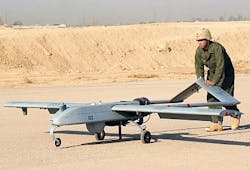L3 to develop high-resolution night-vision sensor payload for Marine Corps tactical UAVs
STENNIS SPACE CENTER, Miss., 25 Oct. 2012. U.S. Navy researchers are asking night-vision sensors experts at L-3 Integrated Optical Systems in Wilmington, Mass., to develop a prototype sensor that enables tactical nighttime wide-field-of-view persistent surveillance from an AAI Corp. Shadow-200 tactical unmanned aerial vehicle (UAV).
Officials of the Naval Research Laboratory at Stennis Space Center, Miss., are awarding a potential $8.9 million contract to L-3 Integrated Optical Systems to develop a medium-wave infrared (MWIR) sensor for the Shadow UAV to perform surveillance over a wide area of the battlefield.
The UAV MWIR sensor will have adequate resolution to enable overall situational awareness of moving objects such as vehicles and personnel with resolution sufficient to classify and identify targets and target details. The base amount of the contract is $5.7 million, and could be worth $8.9 million if all options are exercised.
The Shadow-200 UAV is 11.2 feet long, 3.3 feet wide, and has a wingspan of 14 feet. It cruises at 81 miles per hour, but can achieve a top speed of 127 miles per hour, at altitudes as high as 15,000 feet. The Shadow-200 UAV has a range of 68 miles and can remain aloft for six to nine hours.
The contract is part of a larger ONR program called Wide Area Surgical and Persistent Surveillance (WASPS) Capabilities For Group 3 and 4 UAVs (EMW-FY12-03), which seeks to achieve new sensor and sensor- and information-fusion capabilities to improve battlefield awareness for the Marine Corps.
The program seeks to improve the ability of Marine Corps tactical units to maneuver and project power by fielding UAV-borne imaging sensors at night with high resolution and wide field of view.
The four-year contract will consist of four phases: a base concept refinement phase; a detailed system design phase; a prototype fabrication and physical integration phase; and, an electrical and software integration and testing.
The last phase will be done together with the government at a government or civil airport facilities in the greater Washington D.C. area using either a Shadow or a surrogate aircraft depending on availability.
The L3 MWIR UAV sensor payload will have a multi-axis gimbal hosting large wide field of view optics and a large format MWIR camera small enough for the Shadow 200 UAV.
For more information contact L-3 Integrated Optical Systems online at www.l-3com.com, or the Naval Research Laboratory at www.nrl.navy.mil/field-sites/stennis.
